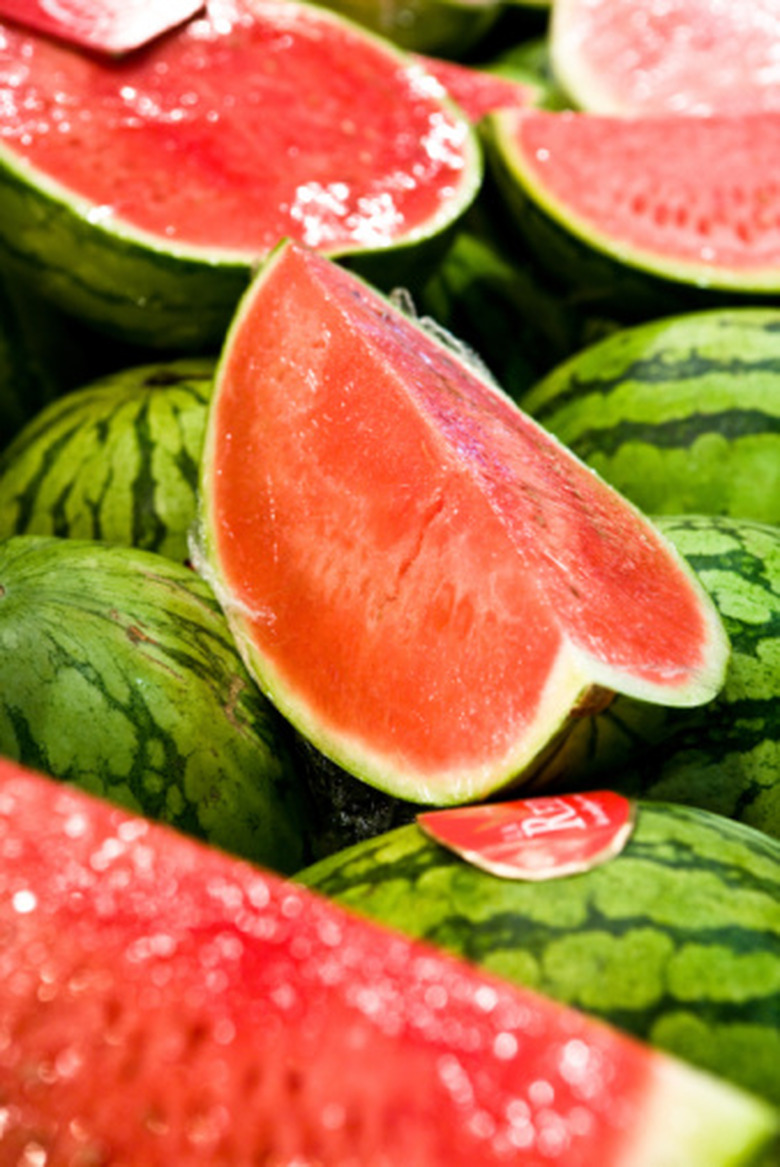How To Make Watermelon Plants Grow Faster And With Big Fruits
Things Needed
-
Soil tiller
-
Organic fertilizer
-
Seeds
-
Organic mulch
-
Liquid fertilizer
-
Pruning shears
-
Umbrella
Growing melons in a home garden is a rewarding but tricky endeavor; you have to provide the fruit with proper light, water, food and space or you will be facing difficulties, such as insect infestations, mold growth and stunted produce. Watermelons in a home garden provide a fresh, tasty summer staple for your family, but to grow the best and largest fruit, you must take extra care to ensure that the melon vines receive only the perfect amounts of the needed ingredients for a good harvest.
Step 1
Till an area of your garden that receives at least six hours of direct sunlight each day. Till to a depth of at least 10 inches to break up all weed roots and freshen the soil.
Step 2
Add 2 to 3 inches of organic fertilizer such as manure, compost or peanut hulls and mix them in with the tiller. These will aid in drainage and also in the fertility of the soil. This prep work should be done as soon as the soil is workable in spring.
Step 3
Plant your watermelon seeds in your prepared soil as soon as the soil temperature reaches 68 degrees Fahrenheit or above. If you are going for the largest watermelon possible, plant Carolina Cross seeds, which can reach up to 200 lbs. These take 90 to 95 days to fully mature. Space the seeds with 12 feet of open area in all directions for largest fruits.
Step 4
Mulch around the base of the watermelon plants with 2 to 3 inches of organic mulch. Keep the mulch at least 6 inches from the plant to avoid burning. The mulch will help the soil retain moisture and battle weeds.
Step 5
Fertilize the watermelon plant once per week with liquid soluble fertilizer. Start with a 20-10-20 measurement of fertilizer until the flowers of the plant bloom. Then switch to a 20-20-20 fertilizer for the rest of the season. Follow specific product instructions regarding dilution and application rates.
Step 6
Encourage fruit production by fertilizing the female flowers, which are larger than the males and have small watermelons attached. Remove a male flower from the plant and swipe it over the open female flower to encourage the fruit to grow and set.
Step 7
Water the plants deeply once per week until the fruit sets. The soil should dry slightly between each watering, so water only if the top 2 inches feel dry to the touch. Once the fruit set, increase watering so that the soil does not dry out at all, but rather is kept consistently moist. Water only from the base of the plants to keep the leaves and fruit dry.
Step 8
Prune off all other fruit once you have a single watermelon set. This will enable the plant to put all of its energy and nutrients into the one healthy plant, making it grow larger and faster. You will probably plant more than one seed, so you will have one large fruit from every plant.
Step 9
Place the growing melon on top of the mulch to prevent it from sitting in moist soil. Set an umbrella or other form of shade over the melon only to protect it from direct sunlight; you want the plant to receive full sunlight, but the fruit to be protected.
Tip
The Carolina Cross is your best bet at growing a gigantic watermelon, but other watermelons mature faster and grow relatively large with the proper care. The fastest a watermelon can be ready for harvest is 70 days after planting. These quick-growing species generally reach between 6 and 10 lbs. and include the golden crown, sugar baby, yellow baby and yellow doll varieties. Most watermelons take 80 to 85 days to be ready for harvest.
You can start watermelon seeds indoors in pots if you want to get a jump on the growing season. Plant them in a pot with drainage holes and quick-draining potting soil 1 inch deep and keep the soil consistently moist but not wet. Transplant the seeds outdoors when soil temperature reaches the appropriate level, after hardening off, or gradually exposing the seeds to lower temperatures and less water consumption.
Animals like deer and raccoons will try to eat ripening melons. Use a screen or fence to keep these pests away.
